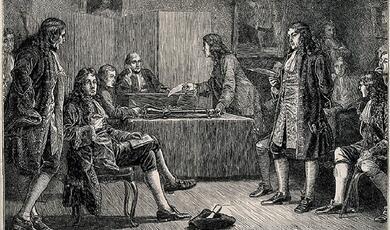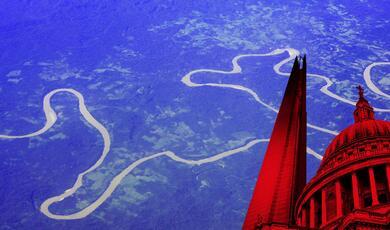Health on the ocean waves: The sea-doctor afloat and in port
Share
- Details
- Text
- Audio
- Downloads
- Extra Reading
A lecture by Professor Allan Chapman, University of Oxford
Download Text
HEALTH ON THE OCEAN WAVES: THE SEA DOCTOR AFLOAT AND IN PORT
Professor Allan Chapman
Ever since mankind began to make long-distance voyages, often involving weeks or months away from the sight of land, nautical health and sickness began to emerge as specific problems in their own right. And while we know that the peoples of Polynesia had been navigating the Pacific Ocean for centuries before any European saw that Ocean, it is really from the 16th Century A.D., that “nautical medicine” as such began to emerge. For while broken bones, hernias, infectious diseases, and battle injuries sustained at sea were well known in antiquity the special circumstances involved in the great maritime expansion after about 1460 introduced a new set of problems that had to be contended with.
But the oldest and most enduring of these problems involves the transmission of infectious disease. The idea of social quarantine goes back into the remote past, and even the Jews of the Old Testament (Levitius, Bks. XIII-XIV) realised that leprosy was best kept in check by removing the individual lepers to designated places outside the main social group. It was the Black Death of the fourteenth century, however, which brought about maritime quarantine, as the authorities at the port of Ragusa ( Dubrovnik, Croatia ) compelled all vessels arriving from suspect places to anchor at an offshore island for 30 days before entering harbour. This was in 1377 and in 1397 it was extended to 40 days – the duration of Biblical cleansing – to become the Quarantenaria. Other great ports, such as Venice, Genoa and Marseilles soon followed suit. The system was later applied, with varying degrees of success, to infections such as Smallpox, Cholera and Yellow Fever. And while we still impose strict quarantine restrictions on the movement of pets and other animals, modern jet air travel now means that a whole host of diseases from HIV to Tuberculosis can be transferred to every corner of the globe in under 36 hours, passing from human to human.
Yet person to person infection was only one of a variety of illnesses which could afflict seafarers and the inhabitants of the ports which they visited.
It was not infrequently observed by surgeons on long haul voyages, such as Royal Navy expeditions, or whaling ships plying the South Seas, that while common infections often “burned themselves out” after several weeks at sea in an isolated shipboard community, other conditions emerged. The most noteworthy of these was Scurvy. Fit young men would become lethargic, their joints would swell, gums bleed, teeth fall out, skin become tight and dry, and in its terminal stages, coma and death would ensue. Traditional explanations of disease in the 17th and 18th Centuries would ascribe these symptoms to the very dampness of being at sea. In a medical culture which saw natural purgation – of the bowels, stomach, nerves, skin and lungs – as essential to health, the prolonged exposure to a marine environment meant that the body failed to perspire effectively and “poisons” which needed to get out, got trapped within. And Scurvy was the result!
It was Scurvy, however, which led to the successful devising of what is now considered to have been the first properly-conducted clinical trial in the history of medicine, when Dr James Lind, Surgeon on the H.M.S. Salisbury in May 1747 selected twelve Scurvy cases for a scientific experiment. He divided the men into six pairs, and to each pair he gave one particular medication, ranging from cider, through dilute sulphuric acid, to lemon juice. Within six days of treatment, however, the men on lemon juice had made a spectacular recovery, whereas the other five pairs had continued to worsen. But Dr Lind did not see the lemon juice as rectifying a bio-chemical deficiency (for 18th Century medical practice knew of no such concept) so much as promoting correct perspiration and thereby enabling the sick men to get rid of the poisons which supposedly had made them ill. Yet while Captain James Cook had supplied the men on his great exploration voyages of the 1770’s with successful anti-scurvy foods (mainly cabbage based), it was not until 1795 that the Admiralty acted on Lind’s advice and supplied lime juice to the Fleet and, within two years, effectively drove Scurvy out of the Royal Navy.
For much of the 17th and 18th Centuries, however, it often depended upon the initiative of individual commanders and captains, rather than upon Admiralty Policy, to keep crews healthy. Part of Lord Nelson’s genius as an Admiral lay not just in his courage and the brilliance of his command strategies, but also in the care which he took to maintain the good health, physically and psychologically, of the men and officers who served under him. When on blockade duty, for instance, Nelson was assiduous in making sure that beef, bread, wine and beer were in plentiful supply, whole herds of Spanish cattle sometimes being purchased to ensure an abundance of that fresh beef which the sailors loved. For while not in any way claiming to be a scientific nutritionist, Nelson knew by practice that the paralysing effects of Scurvy were not known on vessels that were well stocked with fresh food. And officers like Cook and Nelson were similarly aware of the premier importance of psychological health in maintaining “happy ships”: keep the men well occupied, treat them fairly, do not punish excessively, keep the men well fed and drunk, and always lead from the front. For “happy ships” were the most efficient fighting machines afloat, and had the least number of internal disciplinary problems.
Of course, such policies are not unique to ships, but could also be applied to Army Regiments, or in our own time, to successful business organisations. It was, however, in the tightly confined space of a man’s war, where desertion was impossible but where mutiny was possible, that the mechanics of successful command psychology were first hammered out and shown to work, as mental health, physical health and professional efficiency all had to work hand in glove together.
The first explicit treatise on health at sea was John Woodall’s The Surgeon’s Mate (1617). Influenced by prior sea-doctors, such as John Clowes – Surgeon to the Royal Navy at the time of the Spanish Armada – Woodall’s book is intended as a guide to all aspects of medical practice at sea. How should the surgeon (who was also the ship’s G.P.) stock his large medicine chest to deal with every contingency that might arise on a long voyage? Of course, there was Scurvy. Then there were various types of Venereal Diseases (always common amongst sailors), cuts and bruises, constipation, chronic diarrhoea, ulcers that would not heal, and all manner of other afflictions likely to beset human bodies that rarely washed or changed their clothes. And of course, there were the specifically surgical cases, as Woodall tells his reader how to deal with gunshot wounds, major amputations, and how to manage very severe head injuries within the confines of a ship on the high seas. Hernias were a perennial problem when one considers the enormous amount of heavy pulling and pushing that was essential to handle great sails and to operate heavy capstans. Trusses were far more commonplace than the fabled hook hands or peg legs, of popular imagination when it came to nautical prosthetics, from the Navy of Queen Elizabeth I down to that of Queen Victoria. It is probably impossible to over estimate the importance of the introduction of steam engines into ships and the consequent reduction in the quantity of sheer back-breaking toil necessary to operating a ship at sea.
The surgeon’s chest rescued from H.M.S. Mary Rose, which sank 72 years before Woodall wrote his book, gives us a glimpse of the world of the doctor in a First Rate Mano’ War of King Henry VIIIth’s time. Though the salt water had eroded all the steel parts of this unknown surgeon’s sea chest, the preserved bone and wooden handles of his knives give us a good idea of the range of instruments which he possessed. Then there was a pair of exquisitely made bronze or brass syringes, that would have been used to inject mercury compounds into the bladders of Venereal Disease cases, not to mention a variety of drug jars which would have contained a range of salves and medicines, traces of some of which still remain and have been chemically analyzed. In many ways, however, the basic surgical and medical procedures practised by Mary Rose’s surgeon would not have been that different from those used by Dr Lind, two centuries later, or by
Dr William Beatty, Senior Surgeon to H.M.S. Victory, who tended Lord Nelson after his fatal gunshot wound at Trafalgar in 1805.
It was really during the Victorian age that health on the ocean wave really began to improve. And one crucial contributory factor in this respect was steam propulsion, for by 1880, one could cross the Atlantic in as many days as would once have been weeks. Steam ships, built by iron, were very much bigger – be they ships of war or of peace – more spacious, less over-crowded, better ventilated, were often fitted with water closets and even baths, and had superior food. Quite simply, food kept better over a 2 or 3 week voyage than over one lasting a year, and canning, by the 1860’s, made “fresh” nutritious food the norm, even on long runs to Australia, which might take about 90 days by that time. By the latter half of the 19th Century, sailors in Her Majesty’s Navy were served tea and coffee as well as alcohol, while commodities such as chocolate and soap had become commonplace.
What had once been luxuries in the Wardroom of H.M.S. Victory had become standard items of health and hygiene to the sailors on the gun decks of H.M.S. Warrior after 1860. Warrior, when she was launched in 1860, even had hot baths for the off-duty stokers to scrub down, and a ship’s laundry, with hand-turned washing machines, and drying areas by the hot funnel shafts. Health and hygiene provision had changed beyond recognition in the Royal Navy in 70 years. And surgery itself had similarly been transformed, especially following the discovery of anaesthesia, in Boston, USA in 1846.
Without doubt, the worst “passenger” ships ever to be put to sea were the late 18th Century slave ships, though with the abolition of the slave trade in 1807, convict and immigrant ships to Australia probably qualified as the next worst and most unhealthy craft afloat. Yet by the time that Edward Allchurch sailed out to Australia with his family on the Government immigrant ship Atlanta in 1866, one sees new standards of health and safety being applied even to assisted-passage emigrants. Atlanta was a screw-propelled, sail-assisted iron-hulled vessel which accomplished the run from Plymouth to Australia in 81 days non-stop. She carried 394 passengers, and Edward Allchurch’s diary of the voyage provides valuable insights into the medical conditions of the ship. It seems that it was the surgeon who was the hero in Allchurch’s eyes, for
Dr Sangar was responsible for every aspect of health on board the Atlanta from the attempt to keep personal vermin under control to the attendance upon women in childbirth, huddled into the ship’s hospital. But great care was clearly taken to maintain a happy and a healthy ship and most of the deaths reported in Allchurch’s diary seem to have been those of babies and small children – whose bodies, in bad weather, were simply committed to the Deep by the simple expedient of dropping them out of a porthole!
Health on the Ocean Wave is, in so many ways, a history of the development of modern medicine seen within the microscope of the enclosed world of a ship. For here we encounter the first problems of inter-continental disease transmission and quarantine, the problems of Scurvy and the first clinical trials, the evolution of surgery and the problems encountered in mass-emigration in the Victorian age, and consequently of public health afloat. For ships are really small towns afloat, and many things discovered within their once “wooden world” communities have proved to be of inestimable value in the wider application of medicine and surgery.
©Professor Allan Chapman, Gresham College, 13 March 2006
This event was on Mon, 13 Mar 2006
Support Gresham
Gresham College has offered an outstanding education to the public free of charge for over 400 years. Today, Gresham College plays an important role in fostering a love of learning and a greater understanding of ourselves and the world around us. Your donation will help to widen our reach and to broaden our audience, allowing more people to benefit from a high-quality education from some of the brightest minds.


 Login
Login







